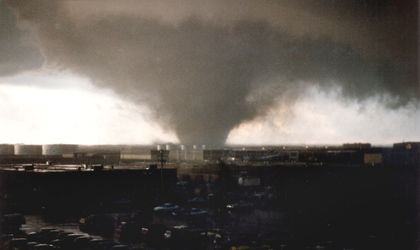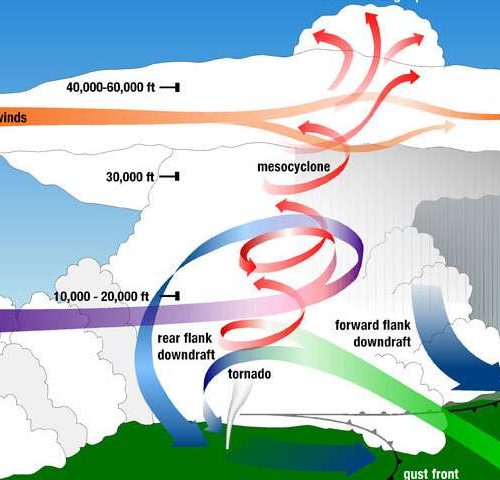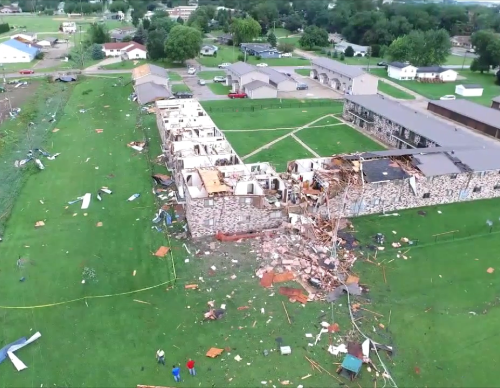The tornado that hit Edmonton on July 31, 1987, killed 27 people, injured hundreds and caused more than $500 million in damage in today’s dollars.
But 30 years later, does it still mean anything to Edmontonians?
Since the day that came to be known as Black Friday, the number of people who saw the destruction first-hand has dwindled as the city’s population has grown.
Memories of the city’s can-do spirit in the days and weeks after the tornado occasionally resurface with the City of Champions debate, but like all memories, they’re fading.
Historian Shirley Lowe, who huddled with coworkers in the basement of Edmonton Centre mall after receiving the tornado warning, said there’s an entire generation of newcomers and young people that have never heard about the massive storm.
“I think we have a very short, perhaps generational memory,” said Lowe.
In the U.S., a tragedy like the Edmonton tornado would be marked as an anniversary every year, she said. “We tend to be a lot more humble about these things — ‘Well we got over that, let’s go on to the next thing’.”
“I think it’s Canadian,” she continued, “and I don’t know if it’s exclusively Canadian, but I think it’s Canadian in the way that we don’t really tell our stories. I think we think we’re always formative, that we’re too young to have stories.”
While memories of Black Friday aren’t what they were, Lowe said those who were there won’t soon forget.
“My son, for years whenever some dark clouds would come, he’d head to the basement, and he was only seven when that happened,” she said. “It’s something that had a lasting effect on us.”
Can you ‘over warn’ about a tornado?
Edmonton’s deadly 1987 tornado was a sea change for how severe weather is monitored in Canada.
The storm, which killed 27 people in Edmonton on the afternoon of July 31, 1987, led to investments in radar emergency warning systems aimed at reducing future death tolls.
But how much warning is too much?
“People want more warnings, but is there a possibility of actually over-warning people?” said Environment Canada meteorologist Dan Kulak. “It’s a real thing social scientists are trying to understand.”
The Black Friday tornado didn’t strike without warning. Television and radio stations carried warnings about severe thunderstorms throughout the day as a cold front mingled with the hot air that had persisted in the lead-up to July 31. But that technology was rudimentary, at least when compared to today.
Tom Taylor, a weather spotter, first reported that a funnel cloud had touched down near his Leduc-area farm, at which point Environment Canada issued its tornado warning.
Kulak said the biggest change to come out of Black Friday was Doppler radar. The Carvel station that covers the Edmonton area had conventional radar in 1987, which was not as effective at identifying storms. Carvel was “Dopplerized” in 1991 — the second civilian radar in Canada to have the capability and the first of four such radars to be installed in Alberta.
After Black Friday, Alberta also developed the Emergency Public Warning System (EPWS), which launched in 1992. The public warning system was the first to use media outlets to broadcast storm information directly to the public. The system was rechristened Alberta Emergency Alert in 2011 when radio and TV moved from analogue to digital systems.
Now, Environment Canada’s Prairie and Arctic Storm Prediction Centre issues 35,000 bulletins per year out of its Edmonton and Winnipeg offices. The office, which covers most of Western Canada and the Arctic, puts out 3,000 weather warnings and 1,000 watches during summer storm season.
Kulak said Environment Canada tries to strike a balance between providing too much and not enough information.
“Thirty years ago, (when) the Edmonton tornado happened, how many people knew about the warnings that went out?” he said. “That was one of the challenges back then — dissemination of the information. We didn’t have the internet, we didn’t have social media, we had a teletype circuit basically. Everything’s changed since then … it’s instantaneous.”
But that creates the potential for too much severe-weather information.
“If you can give people a two-hour warning that a tornado is coming to any particular municipality … will you have a better response than if you gave them 15-minutes warning? Would less people be injured, less people killed?” he said.
Some might take a two-hour warning as permission to run a few errands before hunkering down, he said.
“A lot of people won’t take action until they actually see something coming based on their own personal experience,” he said. “That’s a reasonable thing you have to get past.”
by Jonny Wakefield
July 31, 2017





